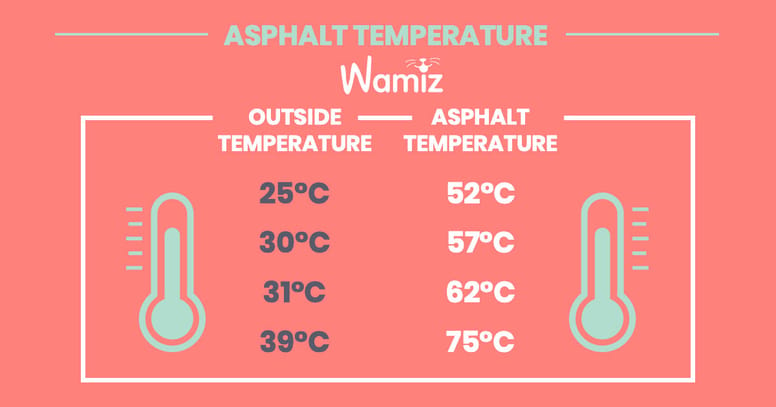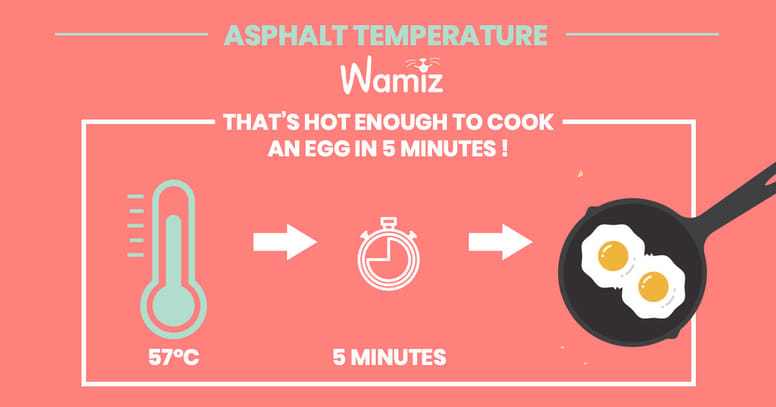Heat exhaustion can quickly worsen if an individual has no access to shade, water, or is exercising excessively, in which case it can rapidly lead to heatstroke, which can be fatal.
Thankfully, there are easy ways owners can ensure their pets stay safe during the hot summer months!
What is heatstroke?
Heatstroke is a state of hyperthermia in which the body temperature is elevated above its normal range. Generally speaking, a dog’s body temperature is too high from 39.2 degrees Celsius and upwards. High temperatures such as the ones we experience during the summer months are a major precursor to heatstroke, as it brings pets' body temperatures so high that they are no longer able to lose heat.
Heatstroke is a life threatening condition which can cause heat injuries to major tissues and internal organs, sometimes to the point where they stop functioning. Multiple organ failure can rapidly lead to death if not treated urgently.
Why pets are more vulnerable to heatstroke
While anyone can suffer heatstroke, many pet owners are unaware that our dogs and cats are particularly susceptible.
Unlike people, dogs cannot sweat out their excess body heat. While they do have a few sweat glands under their paws and around their noses, these are not enough to regulate their body temperatures effectively. Instead, dogs cool themselves by panting – but this doesn’t always stop them from overheating.
And let’s not forget that both cats and dogs (or most of them at least), have fur coats! If you’re hot in this weather, imagine how they feel!
What animals get heat stroke?
Every animal is at risk of heatstroke; however, some are predisposed to the condition.
Indeed, dogs with especially thick or long coats will suffer from the heat more easily. If your animal has a coat that can be shorn/trimmed down, you should go ahead and relieve her of an excess layer. However, you should never completely shave an animal’s coat, as their coats are an aid in regulating their body temperatures.
Just like in humans, the young and old are the most vulnerable. You will need to be extra vigilant with puppies and senior dogs during the heatwave.
Brachycephalic (short-snouted) dogs are also more likely to suffer from heatstroke, due to their breathing difficulties. These include French Bulldogs, English Bulldogs, Boxers, and Pugs, to name a few.
Many medical conditions can also predispose an animal to heatstroke, including obesity, and respiratory, cardiovascular, or neurological diseases.
What are the signs of heat stroke in a dog?
In order to keep your pet safe throughout the summer, ensure you are aware of the signs of heatstroke. It is, however, best to intervene even earlier, when you notice the signs of heat exhaustion.
Heat exhaustion
- Reddening skin inside ears
- Rapid panting
- Lethargy
- Diarrhoea
- Nausea and vomiting
Heat stroke
- Rapid panting
- Breathing distress
- Rapid heart rate
- Drooling, salivating
- Bright red tongue
- Red or pale gums
- Thick, sticky saliva
- Glazed eyes
- Agitation, restlessness
- Depression, lethargy, weakness
- Mental confusion, delirium
- Dizziness, lack of coordination
- Fever
- Vomiting – sometimes with blood
- Diarrhoea
- Little to no urine production
- Muscle tremors
- Seizures
- Loss of consciousness/collapse
- Shock
- Coma
How do you treat heat stroke in dogs?
If you recognise any of the above symptoms, you should first administer emergency treatment yourself, but nonetheless, your pet will need veterinary attention.
- Immediately move your pet to a cooler area: indoors where there is air conditioning or a fan
- Place your pet on a wet towel
- Apply tepid/cool water (not cold water) onto your dog’s fur and skin, especially the neck, armpits, between the legs, the ears, and the paws
- If he’s conscious you can give him cool water to drink (not cold water). Don’t force it though, as it could end up in his lungs.
- Call the vet in advance so they can prepare for your imminent arrival.
What do vets do for heat stroke in dogs?
Heatstroke is a life threatening condition which can have long-term effects on your pet, even if the damage doesn’t show straight away. You should always bring your pet for veterinary attention if she has suffered heatstroke, even if you’ve been able to calm the symptoms.
The vet will probably start by re-hydrating your pet by putting her on a drip. The vet may also administer cooling treatments such as an enema, and will be able to provide supplemental oxygen or medication as needed.
Your vet will also perform a blood test to check for potential blood clotting or abnormal organ function, and will be able to monitor your pet’s health long-term, following the incident.
Heat stroke recovery and aftercare in dogs
If it’s caught on time, most dogs will recover well from heatstroke. However, if you wait too long to treat your dog, or if your dog is particularly vulnerable to the heat, then long-term damage to their organs could occur.
If this is the case, your vet may prescribe a special diet or medication to help your dog recover from and/or cope with any long-term complications. Some of these include rhabdomyolysis, hepato-billiary damage, neurological dysfunction, acute respiratory distress syndrome (ARDS), sepsis, acute kidney injury (AKI), acute pancreatitis and DIC.
Whatever the case, you’ll need to make sure your dog takes it easy for a few days after they suffer from their heatstroke. The more you pamper your pooch, the faster they’ll recover!
How to prevent heatstroke in pets
The best way to treat heatstroke is, of course, to prevent it! On hot days when temperatures start soaring above 30 degrees, special precautions must always be taken to avoid the worst.
- Limit exercise
- Walk your dog early morning and late evening when temperatures are cooler, and avoid asphalt or concrete.
- Give your dog a trim (but never shave the coat – this could make things worse!)
- Provide free access to plenty of drinking water. You can also put ice cubes in their water bowl to keep it cool!
- Let your dog play in the pool or with sprinklers
- Wet your dog down regularly with a damp towel or purchase a cooling vest for them
- Give your dog ice cubes or frozen treats
- Keep your pet inside if you have air conditioning or a fan. If your home is well insulated and the temperature outside is warmer than inside, it is recommended to keep windows and blinds closed to keep the fresh inside.
NEVER:
- Leave your dog or cat in direct sunlight without shade or water
- Leave your dog inside a parked car (the temperature inside a hot car can rise to twice the outside temperature in a matter of minutes).
- Put a muzzle on your dog (which can stop them from panting effectively)
- Give your dog ice cubes or cold water/ice water if he is suffering from heat stroke: the sudden drop in temperature could lead to shock

©Wamiz


©Wamiz


We must take care of those around us who are most vulnerable. Our pets love us more than anything and would do anything for us - let's make sure we do the same for them.

